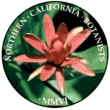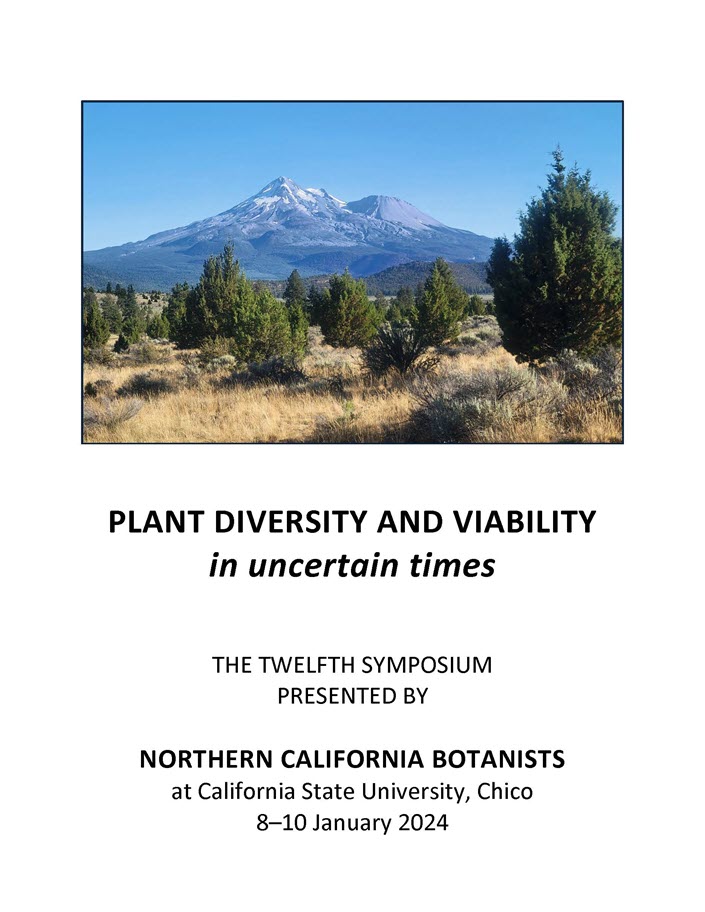Program and Workshops
Plant Diversity and Viability in Uncertain Times
2024 Symposium Program
You can download the program here.
8-9 January 2024
Monday, 8 January
7:30 Check-in begins for registered participants and poster set-up
8:45 Opening Remarks
Linnea Hanson, President of Northern California Botanists
8:45 Welcome:
David Hassenzahl, Dean, College of Natural Sciences, California State University, Chico
9:00 Session 1: Climate Change
Session Chair: Russell Huddleston, Environmental Protection Agency, Region 9
Monitoring alpine plants as climate changes, a GLORIA Great Basin update.
Jim and Catie Bishop, GLORIA Great Basin
Subalpine and alpine plant community turnover in Yosemite National Park following 30 Years of climate warming.
Rachel Friesen, Cal Poly, San Luis Obispo
Climate change and vernal pools on the Modoc Plateau.
Kyle Merriam, U.S. Forest Service
Phenological shifts in flowering and plant pollinator interactions.
Laura Lampe, California State University, Chico
10:20 Break
10:40 Session 2: Bryophytes
Session Chairs: Ben Carter, Director of the Carl W. Sharsmith Herbarium (San Jose State University and Drought Mitigation Specialist, California Department of Fish and Wildlife
New insights into the evolutionary history and floristics of California’s non-vascular plants.
Ben Carter, Director of the Carl W. Sharsmith Herbarium and Associate Professor, San Jose State University
Species delimination of a moss clade in a global hotspot for Bryophyte diversity.
Larke Reeber, San Jose State University
Bryophyte flora of Henry W. Coe State Park.
John McLaughlin, San Jose State University
The relationship between sexual condition, sex chromosomes, and ploidy in Syntrichia.
Jenna Ekwealor, Assistant Professor, San Francisco State University
12:00 Lunch
12:00 - 1:00 Lunch Time: Career Panel for Students and Emerging Professionals in Botany
1:20 Session 3: Vegetation Classification
Session Chair: Teresa Sholars, Professor Emeritus, College of the Redwoods
Nearing the finish-line: A path forward to completing a state-wide vegetation classification and fine-scale map.
Rachelle Boul, California Department of Fish and Wildlife
Updated vegetation concepts for Northern California Coast Ranges and the Modoc Plateau.
Betsy Harbert and Jaime Ratchford, California Department of Fish and Wildlife
A few observations of herbaceous plant communities from the fascinating San Joaquin Desert Region of the Central Interior Coast Ranges.
Alex Hubner, Botanist & Horticulturist, UC Santa Cruz Arboretum Native Plant Program
Fine-scale vegetation mapping & inventory across the Greater San Francisco Bay Area, California: With a focus on Alameda & Contra Costa counties.
Julie Evens, California Native Plant Society
2:40 Break
3:00 Session 4: New Discoveries
Session Chair: Len Lindstrand III, Sierra Pacific Industries
Distribution and discovery of Northern California bryophytes.
Jim Shevock, California Academy of the Sciences
Looking for one thing and finding another: Phylogenomic study of Eriodycton capitatum (Namaceae) resolves the placement of the enigmatic Nama rothrockii.
Matt Guilliams, Santa Barbara Botanic Garden
New taxa from the Marble Mountains.
Dana York, Botany Research Associate, California Academy of the Sciences
A new Lewisia from the Southeastern Klamath Ranges.
Jessica O’Brien, Sierra Pacific Industries
4:20 Session 5: Lightning Talks
Session Chair: Kristen Kaczynski, California State University, Chico
Monday Evening Activities
5:15 - 6:15 Reception: A No-Host Bar with complimentary hors d’oeuvres will be held in Colusa Hall.
6:30 Banquet (tickets required): Buffet dinner menu still to be determined.
7:30 Keynote Speaker: John Vollmar, President/Principal Ecologist, Vollmar Natural Lands Consulting, Inc.
Title of Talk: “The Heart of Conservation - Engaging Human Passion for Conservation Success”
Tuesday, 9 January
8:00 Check-in for one late arrivers
8:30 Session 6: Poster Session (BMU, Room TBD)
Session Chair: Jane Van Susteren, California Board of Forestry
10:00 Second Day Opening Remarks
Jane Van Susteren, California Board of Forestry
10:10 Session 7: Grassland Restoration
Session Chair: Jane Van Susteren, California Board of Forestry
Restoration of coastal grasslands during climate change.
Justin Luong, Cal Poly, Humboldt
Coastal prairie restoration in Manchester State Park.
Terra Fuller, Sonoma Mendocino Coast District, California State Parks
Restoration of meadows in the Sierra.
Evan Wolf, Evan Wolf, LLC
Restoration of plant/pollinator mutualisms in serpentine grasslands.
Rebecca Nelson, Harrison Lab, University of California, Davis
11:30 Lunch
12:50 Raffle, Auction, and Awards
1:20 Session 8: Local Floras
Session Chair: David Magney, Principal Biologist, Althouse and Meade, Inc.
Methods to develop locally rare plant lists using Ventura Flora as an example.
David Magney, Principal Biologist, Althouse and Meade, Inc.
Checklist of the flora and locally rare taxa of San Mateo County.
Toni Corelli, Santa Clara Valley Chapter, California Native Plant Society
Inspirations and development of A Flora of Napa County with some lessons learned.
Jake Ruygt, Napa Botanical Survey Services
Built on a legacy—Second edition of Vascular Plants of San Luis Obispo County, California.
David Keil, Professor Emeritus, Cal Poly, San Luis Obispo
2:40 Break
3:00 Session 9: Now the Good News
Session Chair: Joe Silveira, U.S. Fish and Wildlife Service, Retired
Vegetation trends and cycles in the fire-prone landscapes of Lake, Napa, and Sonoma counties.
Arthur Dawson, Baseline Consulting
Floodplain restoration on disconnected gravel bars in the Sacramento watershed.
Michael Rogner, Associate Science Director, River Partners
Adventures and discoveries during 30 years of conservation work at Fort Ord National Monument (1993 – 2023).
Bruce Delgado, Biologist, Fort Ord National Monument, Bureau of Land Management and Aubrie Heckel, Botanist, Fort Ord National Monument, Bureau of Land Management
Frank & Joan Randall Preserve: botany, vegetation & conservation overview of the 82,000 acres at the convergence of the Tehachapi and Southern Sierra Mountain ranges.
Zach Principe, Project Director, The Nature Conservancy and Neal Kramer, Kramer Botanical
4:20 Closing Remarks
Linnea Hanson, President of Northern California Botanists
2024 Post Symposium Workshops
10 January 2024
Optional post-symposium workshops are scheduled for the Wednesday following the Symposium. You do not have to attend the Symposium to register for a workshop. To register for a workshop, visit the Registration Page.
Workshop 1 is full - we will not take any more signups.
Workshop 1: Soils, Landforms, and Vegetation of Big Chico Creek Canyon and Beyond
Instructors: Andrew Conlin, Soil Scientist, Chico Soil Survey Office, Natural Resources Conservation Service
Time: 8:30 a.m. – 3:00 p.m. (bring a lunch and hiking shoes)
Meet: Highway 32 Park & Ride (carpool to Upper Park Wildwood Avenue to parking lot at north side of 5-Mile bridge; commute time is approximately 10 minutes).
Location: Big Chico Creek Canyon & adjacent Cascade foothills, Bidwell Park
Cost: $25 (limit of 30 participants)
Description:
This trip begins in the floodplain of Big Chico Creek and travels back in time across the older deposits of the creek and up onto the Cascade foothills. The first route covers a condensed sequence of the major landforms that occur in the Sacramento Valley, as well as the transition to the Tuscan Formation in the Cascade foothills— in less than 1 mile. The second route is a 1.5-mile, one-way walk up the bottom of Big Chico Creek Canyon, applying what was observed on the first route and viewing the slot canyon in the Lovejoy basalt, which controls the stream dynamics in this reach of the canyon. Vegetation and habits will be correlated to soil characteristics and landforms along both routes. Understanding the relationship of soils, geologic landforms, vegetation and plants is essential to recognizing landscape features foundational to natural history study and essential to ecological habitat restoration and associated research.
This is a 6-hour (+/- ½ hr.) field trip.
Workshop 2: Heritage Growers Source Identified Native Seed Production Facility Tour
Time: 8:00 am – 12:00 pm (arrive at Heritage Growers at 9:00; bring a lunch for an hour-long post-tour chat & networking)
Meet: Highway 32 Park & Ride (commute time is approximately 1 hour; carpooling arrangements can be made at the symposium on Monday and Tuesday).
Location: Davis Ranches Farm Headquarters, 7681 Sycamore Slough Road, Colusa, CA 95932.
Cost: $25 (limit of 35 participants)
Description:
This field trip is a tour to the Heritage Growers source identified native seed production facility. It will cover all aspects of the numerous steps involved in the production of restoration appropriate native seed. The tour will include a visit to Heritage Growers’ demonstration garden where new ecotypes and new species are trialed, seed is produced for the nursery operation and small plot amplifications are implemented. We will also visit Heritage Growers’ production fields where more than 100 distinct species and ecotypes are produced over approximately 170 acres. Discussions will include methods for field establishment including direct seeding and plug installation, how fields are maintained including irrigation and weed control, how seeds are harvested including how large farm equipment such as swathers and combines are utilized to efficiently harvest seed at scale. The field trip will cover the seed conditioning (cleaning) process including how seeds are dried, the various methods used to clean seed and how the seeds are stored, tested, and retested. Woven throughout the fieldtrip will be examples of various Best Management Practices Heritage Growers use to maintain genetic integrity of different ecotypes.
This is a 3-hour tour that will also include an additional, optional, 1-hour lunchtime gathering where we will discuss source identified native seed issues, including the importance and advantages of selecting local ecotypes for ecological habitat restoration.

